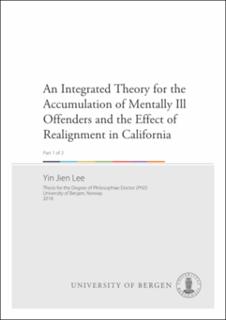| dc.description.abstract | High mental illness prevalence in California state prisons has drawn much attention of scholars and policymakers in the past three decades. Various studies suggest that the mental illness prevalence in prison has increased from 0.14 to 0.3 from 1987 to 2014. The problem with a high concentration of mentally ill prisoners culminated when the California Department of Corrections and Rehabilitation (CDCR) was sued for the violation of inmates’ rights under the Eighth Amendment in the early 1990s. Consequently, CDCR’s health care was placed under Federal receivership to reform prison health care. Receivership is an uncommon remedy adopts by a federal court when other court orders have failed to remedy an institutional violation. The Receiver is tasked with the responsibility to upgrade CDCR’s health care system to the constitutional level and ensure the sustainability of the reformed health care system. In 2011, the State government introduced the Realignment policy to reduce the prison population in order to make room for prison health care reform. Our study aims to understand the pathways through which the mentally ill individuals end up and remain in prison, investigate the effect of the Realignment policy, and identify the high impact leverage points to sustainably reduce the mental illness prevalence in prison. We develop a simulation model to integrate theories from the criminology, criminal justice, and public health literature to advance our understanding about the problem from a holistic perspective. We also use the model to evaluate the effectiveness of the Realignment policy and suggest additional policy to reduce the number of prisoners with mental illness. The Realignment policy, with its focus on diverting the inflow of first time or reoffending prisoners from prison to jail, is a drastic intervention to the correctional system. Under Realignment policy, prisoners without mental illness progress through the system at a faster rate and more of them become desisting ex-convicts. This is because the pathway for prisoners who are placed on county parole supervision to desistance is shorter and the deterioration of social capital of this population is less severe. Hence, this population has a higher probability of reintegrating into the society. However, prisoners with mental illness benefit little from this reform because some of them are ineligible for county parole supervision. Thus, they have to serve parole under CDCR, which takes longer time. Additionally, the lack of community services for parolees with mental illness increases the difficulty to rehabilitate this group of individuals. Consequently, the burden of rehabilitating parolees with mental illness is shifted back to the prison system when these parolees reoffend. Eventually, offenders with mental illness are recycling in and between the criminal justice system and community. In order to sustainably reduce the prevalence of mental illness in prison and the criminal justice system, the Realignment policy alone is insufficient. Instead, the policy needs to be complemented with additional policy, most notably by diverting the severe mentally ill prisoners to an alternative setting where they serve their sentence and receive treatment for their illness. The criteria for discharging these prisoners is contingent upon their recovery and ability to lead normal social lives. At the same time, we propose a feedback structure in correctional resource distribution and community service planning to meet the needs of parolee with mental illness. This additional feedback structure links the expected needs for mental health care and community services to resource and capacity planning. Lastly, we recommend the inclusion of natural depreciation rates in prison and jail capacity planning to avoid steady state error. Prison and jail facilities wear down due to the natural wear-and-tear. This expected loss of capacity is added to the additional new capacity to be built. The contribution of this study is threefold. First, it develops an alternative explanation for the increase in mental illness prevalence in prison. The prevailing theories attribute the increase in mentally ill prisoners to the poorly planned deinstitutionalization movement when the large-scale reduction of mental health hospital took place from the 1960s to 1970s and “war on drugs” policy in the 1980s. Second, the model-based analysis reveals that the Realignment policy is ineffective in reducing the mentally ill prisoner. Third, this study offers insight into how the Realignment policy could be revised to assist mentally ill prisoners and ex-convicts to the path of desistance. Furthermore, the simulation model that integrates and formalizes theories from various disciplines can be used as decision-making tool to guide stakeholders in identifying areas for further research and conduct experiments for policy scenario testing. | en_US |

